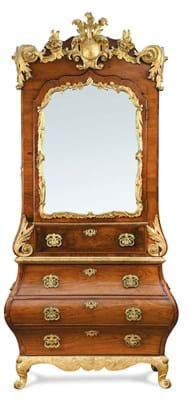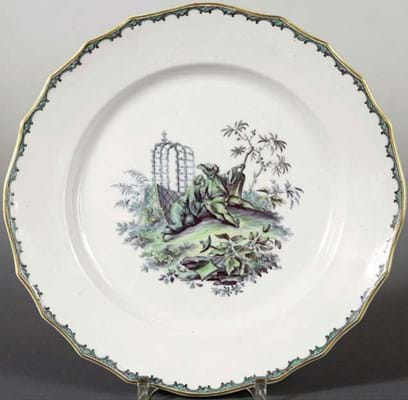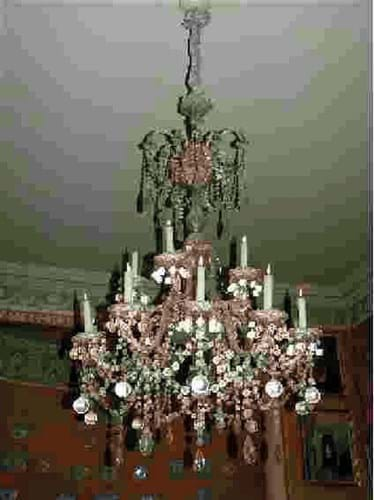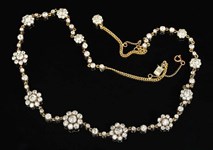Top-seller at Cambridge on September 11-12 was a late 19th century carpet from the Sultanabad region of Persia. With a central field of stylised flowers and foliage on a cream ground with blue and red multiple borders, the 25 x 15ft (7.74 x 4.62m) carpet, pitched at £10,000- 15,000, went to the specialist London trade at £38,000.
Next best was a 19th century two-tier, 15-branch, cut-glass chandelier in the manner of Thomas Osler, founder of the premier Victorian maker FC Osler of Birmingham.
The 6ft 3in x 3ft (2.03m x 92cm) chandelier was estimated at a conservative £2000-4000 but sold to a private bidder from Bedfordshire at £21,000.
Keen collector
Both pieces came from the contents of Mawley Hall in Shropshire. The elegant house had only two owners since it was built in 1735 and sold last year but, if that implies a continuity of contents, this was not the case. As the catalogue pointed out, it was scheduled for demolition before being bought in 1963 by the late engineering businessman Anthony Galliers-Pratt.
It needed almost total refurbishing and Galliers-Pratt, who brought some fine material from his former home, was a keen collector and had a good eye.
As a result, more than 90% of the 141 lots from the hall got away to a hammer total £370,000. Overall the sale totalled £870,000 with the 595 lots enjoying an 86% success rate.
Another chandelier was among the best-sellers. Illustrated in the Bid Barometer column of last week’s ATG (No 2410), this was a c.1820 Régence style, 10-branch ormolu work by noted London maker Johnston Brooks & Co. Drilled for electricity, the 3ft 9in (1.15m) tall chandelier retained its original gold leaf and is believed to be a matching pair for one supplied in 1823 to Burghley House, Peterborough, home of the Cecils since the 16th century.
Against hopes of £7000-10,000, it sold via thesaleroom.com to the London trade at £15,000.
Chippendale shock
The biggest surprise of the sale was a Pembroke table – a seriously unfashionable form and moreover a thoroughly battered piece but of Chippendale style and period.
Featured in last week’s ATG news pages, the chinoiserie-style table with faux bamboo and green and gold lacquer went to a London dealer at £22,000, some hundred times the lower estimate.
It bore some similarities to the famous bedroom suite Chippendale made for the State Bedroom at Nostell Priory but it was not part of that 1771 commission, said auctioneer Luke Macdonald, who surmised that two bidders believed the table was by the great man himself.
The rest of the furniture from Mawley Hall performed more in line with expectations, in the occasional case requiring a degree of auctioneers’ discretion.
An example was a mid-18th century padouk and parcel-gilt bombé secretaire-cabinet typical of the pieces made in Altona.
Standing 8ft 2in (2.71m) tall with a panelled mirror door above a fitted fall-front secretaire drawer, it featured applied ormolu pierced cartouches overall and four carrying handles. It had hopes of £15,000- 25,000 but sold at £12,000.
More modestly pitched but an equally imposing piece, a 9ft 2in (2.71m) tall George II walnut and parcel-gilt bookcase with glazed panel doors went a shade over estimate at £6500.
Other solid furniture prices included an above-estimate £6500 for an Irish George III mahogany side table with a 2ft 7in x 4ft 9in (80cm x 1.47m) simulated marble top, and a double-estimate £8000 for a 4ft 3in (1.32m) tall late-18th century giltwood framed oval mirror.
Homeward bound
Best of the clocks by a distance was a German rococo walnut longcase by Johann Rieppolt of Augsburg. In an ornate 8ft 1in (2.49cm) tall case with an 11½in (29cm) dial (signed and numbered 686) the clock has a three-train movement chiming on two bells and striking on a third. It went back home courtesy of a double-estimate bid of £7000 from Berlin.
With international bidding a feature of the sale, more homeward-bound pieces came among half-a-dozen plates from the Tournai factory. All bar one sold and some went way above estimate including a c.1775, 9½in (24cm) diameter plate.
Painted with lovers in a landscape after Boucher and bearing the crossed swords and star mark in gilt (English factories were not alone in borrowing the famous Sèvres mark), it doubled top estimate in selling to a Belgian buyer at £1400.
Fans make £57,000
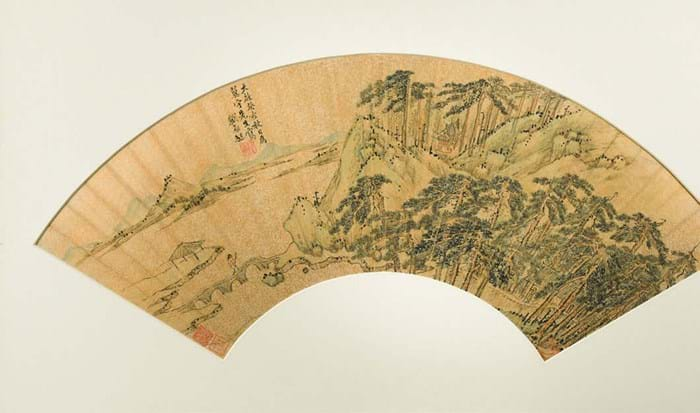
One of six fan leafs catalogued as by a follower of Fu Shan offered at Cheffins - this example made £12,000.
Solid selling was evident throughout the Cheffins sale but the main eye-catcher was a private collection of a dozen Chinese fans. From a deceased estate, they were priced to sell, but the six fan leafs catalogued as by a follower of Fu Shan (1607-84) went considerably above private hopes. Estimated collectively at £1700-3000, they sold at a total of nearly £57,000.
Each in ink on gilded paper laid down on paper, the top-seller was a 19in (49cm) wide leaf with a poem and three seals in red and black ink provenanced to London dealer Sydney Moss. It sold to a US-based Chinese bidder at £14,000 against an estimate of £300-500.
Shown above is a 23in (58cm) wide fan paper depicting in coloured inks a wooded lakeland landscape including a figure on a bridge, with three red seals. It sold to a Chinese bidder for £12,000 (estimate £300-500).


